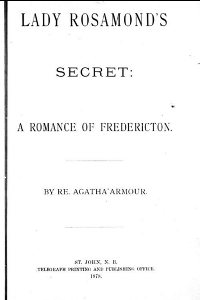Rebecca Agatha (Armour) Thompson

Rebecca Agatha (Armour) Thompson was a daughter, sister, teacher, wife, and author. She was the eldest of the three daughters of Margaret (Hazlett) and Joseph Armour (Sewell and Saunders 12) and was born in Fredericton on 25 October 1845 (Davies). She died of grippe at the age of forty-six on 24 April 1891 (“Ravages”), just six years after she married John G. Thompson. The couple was married at Rebecca’s mother’s residence on Westmorland Street in Fredericton (“Marriages”); they did not have any children. Rebecca’s parents were both Irish, her father immigrating to New Brunswick in 1820. He was a well-known merchant and grocer in Fredericton (Quinn).
Armour taught in various places throughout New Brunswick and wrote four novels and approximately fifty historical sketches (Rhodenizer 711). She titled the sketches “Old Landmarks of Fredericton” and published them anonymously in the city’s newspaper the Capital. Her two extant novels are Lady Rosamond’s Secret: A Romance of Fredericton (1878) and Marguerite Verne; Or: Scenes From Canadian Life (1886). Also extant in New Brunswick libraries are eight of her historical sketches written for the Capital from September to November 1880. The only evidence of her other two novels – Marion Wilburn (n.d.) and Sylvia Leigh; Or, The Heiress of Glenmarle (1880) – and her other historical sketches are their mention in newspapers and in critical overviews of early Canadiana, such as V.B. Rhodenizer’s Canadian Literature in English (711).
Her “Old Landmarks of Fredericton” describe and provide a history of many of the buildings in nineteenth-century Fredericton, while her romantic descriptions in novels reflect her love of the city that was her home. Upon her death, a eulogist in the Fredericton Gleaner noted that “her plots were striking, her style graceful and her language rich in figure” (“Well Known Authoress Dead”).
Lady Rosamond’s Secret is about life in Fredericton in the 1820s. The novel begins with a sentimental view of a Fredericton sunset, its words calming and theatrical as Armour moves through actual landmarks and surroundings. Critic Rhodenizer observes that “she uses the word ‘romance’ practically in the sense of ‘fiction,’ for its style is as full of flushed emotion as it is full of realism” (711).
Marguerite Verne; Or: Scenes from Canadian Life is also a novel of hybridized form (both romantic and realistic), though it is set in the city of Saint John in the 1880s. The novel describes the social dynamics of the port city amidst scenes of romance, class, and economic change. Armour’s interest in physical structures and her skill at description are evident in her depiction of the Verne’s home:
the stately residence of the Verne’s is indeed an imposing structure. Its towering form and massive appearance mark it as one of the noblest piles in St. John. Its costly windows, reflecting all the colors of the rainbow; its solid brick walls, stone pillars and grand entrance, bespeak it the home of wealth and affluence. Even the solid brick pavement leading from the main gateway to the terrace marks the substantial tone of the edifice, and impresses one with the stability of its owner. And the statuary, seen from the highway, denotes the taste displayed in the vestibule, with its floor of tessellated pavement, echoing to the tread of footsteps as the corridors of some grand old cathedral. It is now our privilege to be introduced to the interior, and we make good use of our opportunity while mingling with its guests. (10)
Armour’s lasting value to us is in how she perceived New Brunswick's urban society in the latter part of the nineteenth century. And although her social status and that of the people she wrote about was one of privilege, her sense of Loyalist Fredericton and Saint John gives us important insight into the provincial affairs of New Brunswick’s influential citizens. Eulogized by the Gleaner as “a widely known and accomplished lady” with “an excellent reputation in literary work” (“Well Known Authoress Dies”), she was a significant presence at a formative time of provincial history. It is, then, unfortunate that much of Armour’s work is no longer extant.
Jennifer Atwin, Winter 2015
St. Thomas University
Bibliography of Primary Sources
Armour, Rebecca Agatha. Lady Rosamond's Secret: a Romance of Fredericton. Saint John, NB: Telegraph Print and Pub Office, 1878.
---. Marguerite Verne; Or: Scenes From Canadian Life. Saint John, NB: Daily Telegraph Book and Job Print, 1886.
---. “Old Landmarks of Fredericton.” Capital [Fredericton] 20 Nov. 1880: 2.
---. “Old Landmarks of Fredericton: Backer Property.” Capital [Fredericton] 27 Nov. 1880: 2.
---. “Old Landmarks of Fredericton: The Golden Ball, Waterloo Row.” Capital [Fredericton] 23 Oct. 1880: 2.
---. “Old Landmarks of Fredericton: The Hermitage.” Capital [Fredericton] 2 Oct. 1880: 2.
---. “Old Landmarks of Fredericton: The Old Burying Ground.” Capital [Fredericton] 16 Sept. 1880: 2.
---. “Old Landmarks of Fredericton: Rose Hall.” Capital [Fredericton] 23 Sept. 1880: 2.
---. “Old Landmarks of Fredericton: Royal Oak, Waterloo Row.” Capital [Fredericton] 30 Oct. 1880: 2.
---. “Old Landmarks of Fredericton: Waterloo Row.” Capital [Fredericton] 16 Oct. 1880: 2.
Bibliography of Secondary Sources
Davies, Gwendolyn. “Armour, Rebecca Agatha.” Dictionary of Canadian Biography. Vol. 12. Toronto: U of Toronto P, 1990. Dictionary of Canadian Biography Online. 2003. U of Toronto/U Laval. 26 June 2020
<http://biographi.ca/en/bio/armour_rebecca_agatha_12E.html>.
“Marriages.” New Brunswick Reporter and Fredericton Advertiser 24 Jan. 1885: 3.
“New Brunswick Writers.” Daily Sun [Saint John] 8 Oct. 1894: 3.
Quinn, W.H. Gleaner [Fredericton] 1 Nov. 1895: 3.
“Ravages of La Grippe.” Gleaner [Fredericton] 27 Apr. 1891: 3.
Rhodenizer, Vernon B. Canadian Literature in English. Montreal: Quality Press, 1965.
Sewell, Elizabeth, and Elizabeth Saunders. The New Brunswick Census of 1851, York County. Fredericton, NB: Provincial Archives of New Brunswick, 1979.
“Well Known Authoress Dead.” Gleaner [Fredericton] 24 Apr. 1891: 3.


